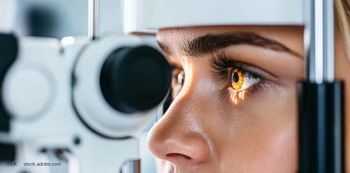
- Ophthalmology Times: September/October 2025
- Volume 50
- Issue 5
Ophthalmic innovation by the decades: The 1980s and 1990s
Key Takeaways
- Excimer lasers enabled precise corneal reshaping, leading to PRK and LASIK, revolutionizing refractive surgery.
- Laser trabeculoplasty, including ALT and SLT, advanced glaucoma treatment by enhancing aqueous humor outflow.
Explore the groundbreaking advancements in ophthalmic technology from the 1980s and 1990s, including excimer lasers, LASIK, and innovative imaging techniques.
The 1980s saw a lot of new technological activity as well as improvements to pre-existing technology, which later developed into the next decade. Here are a few of the standouts.
Excimer lasers and refractive surgery
One topic of great interest was the use of lasers in refractive surgery.
The use of lasers in refractive surgery replaced the creation of radial cuts in the cornea made with diamond blades when radial keratotomy was performed during the 1970s. IBM researchers determined that excimer lasers could precisely remove tissue without causing thermal damage.1 This research led to further exploration of the excimer laser for ophthalmic applications, particularly for corneal reshaping.
The excimer laser uses reactive gases, such as chlorine and fluorine, mixed with inert gases, such as argon, krypton and xenon. When electrically excited, the gas mixture emits energetic pulses of ultraviolet light, which can make very precise, minute changes to irradiated material, such as polymers.1
In 1987, Stephen Trokel, MD, first used the excimer laser to reshape corneal tissue and by so doing introduced PRK, which involved removing the corneal epithelium, to correct myopia and hyperopia.1 He patented the excimer laser for vision correction and performed the first laser surgery on a patient’s eyes in 1987. Trokel and coauthors Rangaswany Srinivasan, PhD, and Bodil Braren, BA, published the concept of using the laser to sculpt the cornea to correct refractive errors, such as myopia or hyperopia, in December 1983.2
The next 10 years were spent perfecting the equipment and the techniques used in laser eye surgery. In 1988, an excimer laser was first used to sculpt tissue from the stromal bed under a hinged flap created manually using a trephine and scalpel. The incorporation of a microkeratome in 1990 finally led to LASIK, and the first excimer laser for this use was approved in the US in 1996.3 LASIK is now the most frequently performed elective refractive surgery in the world.4
A principal innovator involved in LASIK was Lucio Buratto, MD, who proposed creation of a disk (free cap) of cornea made by a microkeratome, followed by refractive excimer laser ablation performed on the back surface of the disk; the disk was then sutured back onto the cornea. This approach ran into difficulties in centration of the optics on the back of the disk. The second innovator was Ioannis G. Pallikaris, MD, who was involved in creating a lamellar corneal flap using a microkeratome that he designed and an excimer laser to recontour the host stromal bed under the flap.4
Lasers and glaucoma
Lasers also became important in glaucoma treatment. By the 1980s, laser technology had become a major player in the management of glaucoma. Laser peripheral iridotomy had replaced incisional iridectomy, and cyclophotocoagulation had replaced cyclocryotherapy and the other cyclodestructive procedures. The hottest glaucoma topic in the early 1980s, however, was laser trabeculoplasty.5
The commonly performed laser trabeculoplasty procedures are argon laser trabeculoplasty (ALT) and selective laser trabeculoplasty (SLT) to increase aqueous humor outflow and thus lower intraocular pressure.6
ALT was first reported by Wise and Witter7 in 1979 in a study in which they demonstrated the safety and efficacy of ALT in patients with open-angle glaucoma (OAG). ALT's safety and long-term efficacy were studied in the Glaucoma Laser Trial,8 in which eyes receiving 360-degree ALT were compared with medical monotherapy with a follow-up period of 2.5 to 5.5 years. The study concluded that trabeculoplasty was as efficacious as medical therapy in reducing intraocular pressure (IOP). However, ALT did not become primary therapy in patients with primary OAG because of the reduction in efficacy over time, so it served as an adjunctive therapy.
Laser trabeculoplasty gained popularity with SLT, which uses a Q-switched frequency-doubled Nd:YAG laser in the trabecular meshwork, which appears less destructive than ALT. However, it was reportedthat both ALT and SLT were equally efficacious in reducing IOP in OAG.6
SLT was developed in 1998 by Marc Latin, MD, and colleagues who sought to overcome the limitations of ALT.9The aim was to trigger a biologic response that improved drainage without causing coagulation damage. The results were encouraging and demonstrated moderate IOP reduction and minimal side effects. Since there was practically no thermal coagulative damage to the trabecular meshwork, it was thought possible that SLT could be repeated in eyes previously treated with ALT or SLT.9
This represented an advancement in laser glaucoma treatment, in that SLT was a more targeted and tissue-sparing technique, and an alternative to ALT.
Another laser procedure that emerged in the 1990s was diode laser trabeculoplasty (DLT). When compared with ALT, DLT effectively lowered the IOP, with comparable results to ALT in some studies. However, it could still cause similar coagulative damage to the trabecular meshwork. A later variation was micropulse DLT10 that sought to reduce tissue damage by using subthreshold energy and repetitive short pulses, minimizing heat buildup. However, the micropulse DLT results varied, with some studies reporting limited IOP-lowering success, and others better results with mean IOP reductions ranging between 19.5% to 22% with a good safety profile. Compared with ALT, the percentage of eyes with IOP reduction over 20% from baseline was lower with micropulse DLT. The technology has not been compared with SLT in large studies.11
Phacoemulsification and cataract surgery
The many changes that occurred in surgical techniques after 1980 and into the 1990s included the introduction of ophthalmic surgical devices, a greater awareness of the advantages of in-the-bag fixation, the introduction of continuous curvilinear capsulorhexis, hydrodissection, and the growing use of phacoemulsification.12
These developments facilitated not only much safer surgeries but also implantation of intraocular lenses (IOLs) through a smaller incision than was possible in the early days of extracapsular cataract surgery.
Following the earlier introduction by Charles Kelman, MD, phacoemulsification did not gain popularity and widespread use until the 1980s. Once it did, a number of innovations were proposed, such as the concept of self-sealing sutureless incisions by Michael McFarland, MD; clear corneal incisions by Howard Fine, MD; development of in-the-bag nuclear fracturing, hydration, and quartering by John Shepherd, MD, in 1990; and introduction of the divide-and-conquer method of nuclear fragmentation by Howard Gimbel, MD, and others.12
The notion of hydrodissection was introduced by Kenneth Faust, MD, in 1984.13 This technique and its variations, ie, cortical cleavage hydrodissection, hydrodelineation, simplify the surgery by mobilizing and removing epithelial cells and cortical material easily, thus decreasing the risk of posterior capsular opacification. With the introduction of continuous curvilinear capsulorhexis, which provided a much safer operating environment, and the security provided by centration of implanted IOL, phacoemulsification came to be used more widely.12
This subsequently led to changes in the designs of IOLs to increase their flexibility and facilitate insertion of foldable models so that the surgical wound would not have to be enlarged. Thus, polymethyl methacrylate (PMMA), which was the original material used to make IOLs, gradually made way for the first foldable silicone material to newer materials such as hydrophobic acrylic, as well as various hydrophilic acrylics and hydrogels.12
IOL implantation became a widely adopted part of cataract surgery in the 1980s.The first multifocal IOLs were introduced in the late 1980s. These early designs were based on either diffractive or refractive principles and were typically made of PMMA.
Flexible supporting elements (haptics) improved the long-term stability of IOLs, and new materials and designs were gradually introduced.
Capsular tension rings (CTRs) were first developed in 1991 in Japan to counter zonular weakness, which can cause numerous problems including capsular tears, vitreous prolapse, nucleus drop, IOL decentration, subluxation and dislocation. These are implanted in the capsular bag to provide support and IOL centration. Cionni, Morcher, and Ahmed are different designs to provide capsular stability.14
Iris hooks were also used first in 1991 for expanding small pupils to aid in cataract extraction.14
Thefirst daily disposable lens, Acuvue (Johnson & Johnson), was launched in 1996, marking a significant shift towards more frequent lens replacement. This evolution was driven by the understanding that more frequent replacement could enhance visual performance and ocular health.15
Diagnostic technology
The work done in the 1980s was pivotal in the evolution of ophthalmic imaging with the emergence and early development of the scanning laser ophthalmoscope (SLO).
The SLO, developed in the early 1980s at the Eye Research Institute, Boston, produceshigh-resolution, non-mydriatic images of the retina. It uses a laser to scan the retina, allowing for detailed imaging and even projection of stimuli for psychophysical studies.16
Since its introduction, this imaging technique has been adapted and optimized for various clinical applications based on different contrast mechanisms. Reflectance imaging, where the back scattered light is detected, is widely used for eye tracking and as reference image for optical coherence tomography (OCT) applications. The reflectance modality itself has several important diagnostic applications: laser scanning tomography, imaging with different laser wavelengths (multicolor contrast), and others. Fluorescence imaging channels with different excitation wavelengths were introduced to SLOs for angiography, ie, for visualization of the vascular system after intravenously injecting an appropriate dye, as well as for autofluorescence imaging of endogenous fluorophores in the retina.16
OCT was introduced in 1991. It is a non-contact and non-invasive technology that uses low-coherence interferometry, in which a beam from a low coherence interferometer is scanned by moving a reference arm that serves as a reference for depth in the axial direction. In the eye, backscattered light from retinal layers is detected sequentially pixel by pixel to form a depth profile (A-scan). Scanning this beam in the transverse plane creates a B-scan, combining all the acquired A-scans. This provides high-resolution, two-dimensional images of the tissue depth structure and can be applied to the entire anatomy of the eye (retina, optic nerve, cornea, and angle). By collecting a sequential series of B-scans, a three-dimensional image can be produced, with volumetric information on the tissue interrogated.17
Ultrasound biomicroscopy (UBM) is a high-resolution ultrasound technique that allows noninvasive in vivoimaging of structural details of the anterior ocular segment at near light microscopic resolution and provides detailed assessment of anterior segment structures, including those obscured by normal anatomic and pathologic relations.18
Instead of using the 10 MHz most widely used in ophthalmic diagnostic ultrasound, UBM uses ultrasound frequencies in the 50 to 100 MHz range, allowing examination of living subsurface ocular tissues at very high resolution. UBM is widely used to image many ocular pathologies from adnexal, conjunctiva, scleral, and corneal tissye, the anterior chamber to the anterior vitreous and retina. However, its major contribution has been to the understanding of the structure of the anterior segment, particularly in glaucoma.18
Indocyanine green (ICG) angiography, in particular, saw increased use in the early to mid-1990s, though its practical applications were later refined.ICG angiography was first performed in humans in 1972, but results were limited by insufficient sensitivity of available infrared films. In the early 1990s, two groups reported improved results with commercially available digital angiography systems. The infrared sensitivity of available CCD cameras was combined with new lens coatings that improved infrared transmission for ICG angiography. In the early to mid 1990s, enthusiasm for this procedure exceeded its practical applications. Use of this technique waned by the late 1990s as clinical research had defined a vital, but limited, role for ICG angiography as an adjunct to fluorescein angiography.19
These advancements, particularly the SLO and the early work on OCT, paved the way for the diagnostic revolution that would occur in the following decades with the widespread adoption of OCT and other advanced imaging techniques.
References
Pidro A, Biscevic A, Pjano MA, Mravicic I, Bejdic N, Bohac M. Excimer lasers in refractive surgery. Acta Inform Med. 2019;27:278–283. doi:
10.5455/aim.2019.27.278-283 Trokel SL, Srinivasan R, Braren B. Excimer laser surgery of the cornea. Am J Ophthalmol. 1983;96:710-5. doi: 10.1016/s0002-9394(14)71911-7.
Reinstein DZ, Archer TJ.
The history of LASIK . J Refract Surg. 2012;28:291–298.https://doi.org/10.3928/1081597X-20120229-01 Krueger RR, Rabinowitz YS, Binder PS. The 25th Anniversary of excimer lasers in refractive surgery: historical review. J Refract Surg. 2010;26. doi:10.3928/1081597X-20100921-01
Shields MB, Hodapp EA. Glaucoma 25 years ago.Glaucoma Today. 2011;35-37.
Shaw E, Gupta P. Laser Trabeculoplasty. StatPearls Publishing.Treasure Island, FL. 2025.
Wise JB, Witter SL. Argon laser therapy for open-angle glaucoma: a pilot study. Arch Ophthalmol. 1979;97:319-322.
The Glaucoma Laser Trial Research Group. The Glaucoma Laser Trial (GLT) 2. Results of argon laser trabeculoplasty versus topical medicines.Ophthalmology. 1990;97:1403-1413.
Mahdy M A-M S. Efficacy and safety of selective laser trabeculoplasty as a primary procedure for controlling intraocular pressure in primary open angle glaucoma and ocular hypertensive patients.Sultan Qaboos Univ Med J. 2008;8:53–58.
Fea AM, Bosone A, Rolle T, Brogliatti B, Grignolo FM. Micropulse diode laser trabeculoplasty (MDLT): A phase II clinical study with 12 months follow-up. Clin Ophthalmol. 2008;2:247–252. doi:
10.2147/opth.s2303 Garg A, Gazzard G. Selective laser trabeculoplasty: past, present, and future. Eye (Lond). 2018;32:863–876. doi:
10.1038/eye.2017.273 Malik C, Panwar N. Evolution of cataract surgery. Current Medicine Research and Practice. 2013;
3: 193-2003. Faust KJ. Hydrodissection of soft nuclei. J Am Intraocul Implant Soc. 1984;10:75-77.
https://doi.org/10.1016/S0146-2776(84)80088-9 Nadeem S. Cataract surgery: historical devices, modern innovations, and future perspectives. Expert Rev Med Devices.2024;21991–994.
https://doi.org/10.1080/17434440.2024.2419477 Brimer CM. Sizing up disposable contact lenses. Optometry Times. 2017; May 22.
Fischer J, Otto T, Delori F, Pace L, Staurenghi G, eds. Scanning laser ophthalmoscopy (SLO). In: High resolution imaging in microscopy and ophthalmology: new frontiers in biomedical optics [Internet]. Chapter 2. 2019; Springer, Cham.
Alexopoulos P, Madu C, Wollsein G, Schuman JS. The development and clinical application of innovative optical ophthalmic imaging techniques (OCT). Front Med (Lausanne). 2022;9:891369. doi:
10.3389/fmed.2022.891369 He M, Wang D, Jiang Y. Overview of ultrasound biomicroscopy. J Curr Glaucoma Pract. 2012;6:25–53. doi:
10.5005/jp-journals-10008-1105 Bennett TJ Barry CJ. Ophthalmic imaging today: an ophthalmic photographer's viewpoint – a review. Clin Exp Ophthalmol. 2009;37:2-13.
https://doi.org/10.1111/j.1442-9071.2008.01812.x
Articles in this issue
about 2 months ago
Transformative advances in vision research: It’s the scienceabout 2 months ago
Anti-VEGF innovations in retinal disease: From molecules to medicineabout 2 months ago
From numbers to meaning: Graphical reporting in refractive surgeryabout 2 months ago
Evolving glaucoma therapy: A new era of interventional strategiesabout 2 months ago
Proactive strategies and sustained delivery advance glaucoma careabout 2 months ago
Periorbital rejuvenation: Past, present, and nextabout 2 months ago
The mechanics of presbyopia: From muscle movement to functional visionabout 2 months ago
Rethinking punctal occlusion as an option for allergic conjunctivitisNewsletter
Don’t miss out—get Ophthalmology Times updates on the latest clinical advancements and expert interviews, straight to your inbox.













































.png)


